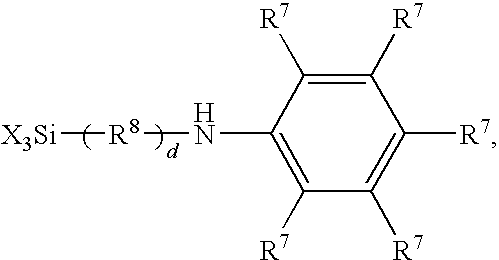Negative photoresist for silicon KOH etch without silicon nitride
a technology of silicon koh etch and negative photoresist, applied in the field of new photoresists, can solve the problems of difficult removal, time and expense, and difficult layering or masking
- Summary
- Abstract
- Description
- Claims
- Application Information
AI Technical Summary
Benefits of technology
Problems solved by technology
Method used
Image
Examples
example 1
1. Terpolymer Synthesis in Cyclopentanone
[0061]A solution was made by dissolving 67.50 g of styrene, 25.00 g of acrylonitrile, 7.50 g of glycidyl methacrylate, and 1.25 g of 2,2′-azobisisobutyronitrile in 400 g of cyclopentanone, all of which were obtained from Aldrich. The solution was heated to 65° C. under nitrogen while undergoing magnetic stirring. The polymerization was allowed to proceed at 65° C. for 98 hours. The actual yield was determined by solids analysis to be 97% of the theoretical yield.
2. Topcoat Solution Formulation
[0062]In this preparation procedure, 25.01 g of propylene glycol methyl ether acetate (PGMEA, General Chemical) and 1.03 g of UVI-6976 (a triarylsulfonium hexafluoroantimonate; a photoacid generator obtained from Dow Chemical) were added to 50.03 g of the terpolymer solution synthesized in Part 1 of this Example. The resulting solution was filtered through a 0.1-μm membrane filter.
3. Primer Solution Formulation
[0063]To make a primer solution, 1.02 g of N...
example 2
1. Terpolymer Synthesis in PGMEA
[0066]A solution was made by dissolving 27.07 g of styrene, 10.00 g of acrylonitrile, 3.08 g of glycidyl methacrylate, and 0.51 g of dicumyl peroxide (obtained from Aldrich) in 160 g of PGMEA. The solution was heated to 120° C. under nitrogen while undergoing magnetic stirring. The polymerization was allowed to proceed at 120° C. for 24 hours. The actual yield was determined by solids analysis to be 95.5% of the theoretical yield.
2. Topcoat Solution Formulation
[0067]In this preparation procedure, 4.54 g of PGMEA and 0.114 g of UVI-6976 were added to 5.03 g of the terpolymer solution synthesized in Part 1 of this Example. The solution was filtered through a 0.1 μm membrane filter.
3. Preparation and Patterning of Negative Photoresist Coating
[0068]The primer solution of Part 2 of Example 1 was spin coated onto a silicon wafer at 1,500 rpm for 1 minute. The primer coating was baked at 60° C. for 5 minutes and at 180° C. for 2 minutes. The topcoat solution...
example 3
1. Terpolymer Synthesis in PGMEA
[0070]A solution was made by dissolving 168.0 g of styrene, 84.0 g of acrylonitrile, 28.3 g of glycidyl methacrylate, and 7.0 g of dicumyl peroxide in 1,120 g of PGMEA. The solution was heated to 120° C. under nitrogen while undergoing magnetic stirring. The polymerization was allowed to proceed at 120° C. for 28 hours. The actual yield was found by solid analysis to be 97.5% of the theoretical. The terpolymer was precipitated in isopropanol, filtered, and dried overnight under vacuum at 50° C.
2. Topcoat Solution Formulation
[0071]In this preparation procedure, 32.8 g of the terpolymer synthesized in Part 1 of this Example were dissolved in 140.0 g of PGMEA and 40.0 g of ethyl acetylacetate. Next, 6.0 g of UVI-6976 were added, and the solution was filtered through a 0.1-μm membrane filter.
3. Primer Solution Formulation
[0072]To prepare a primer solution, 2,04 g of N-phenylaminopropyltrimethoxysilane were dissolved in a mixture of 77.50 g of propylene gl...
PUM
| Property | Measurement | Unit |
|---|---|---|
| boiling point | aaaaa | aaaaa |
| boiling point | aaaaa | aaaaa |
| weight average molecular weight | aaaaa | aaaaa |
Abstract
Description
Claims
Application Information
 Login to View More
Login to View More - R&D
- Intellectual Property
- Life Sciences
- Materials
- Tech Scout
- Unparalleled Data Quality
- Higher Quality Content
- 60% Fewer Hallucinations
Browse by: Latest US Patents, China's latest patents, Technical Efficacy Thesaurus, Application Domain, Technology Topic, Popular Technical Reports.
© 2025 PatSnap. All rights reserved.Legal|Privacy policy|Modern Slavery Act Transparency Statement|Sitemap|About US| Contact US: help@patsnap.com



